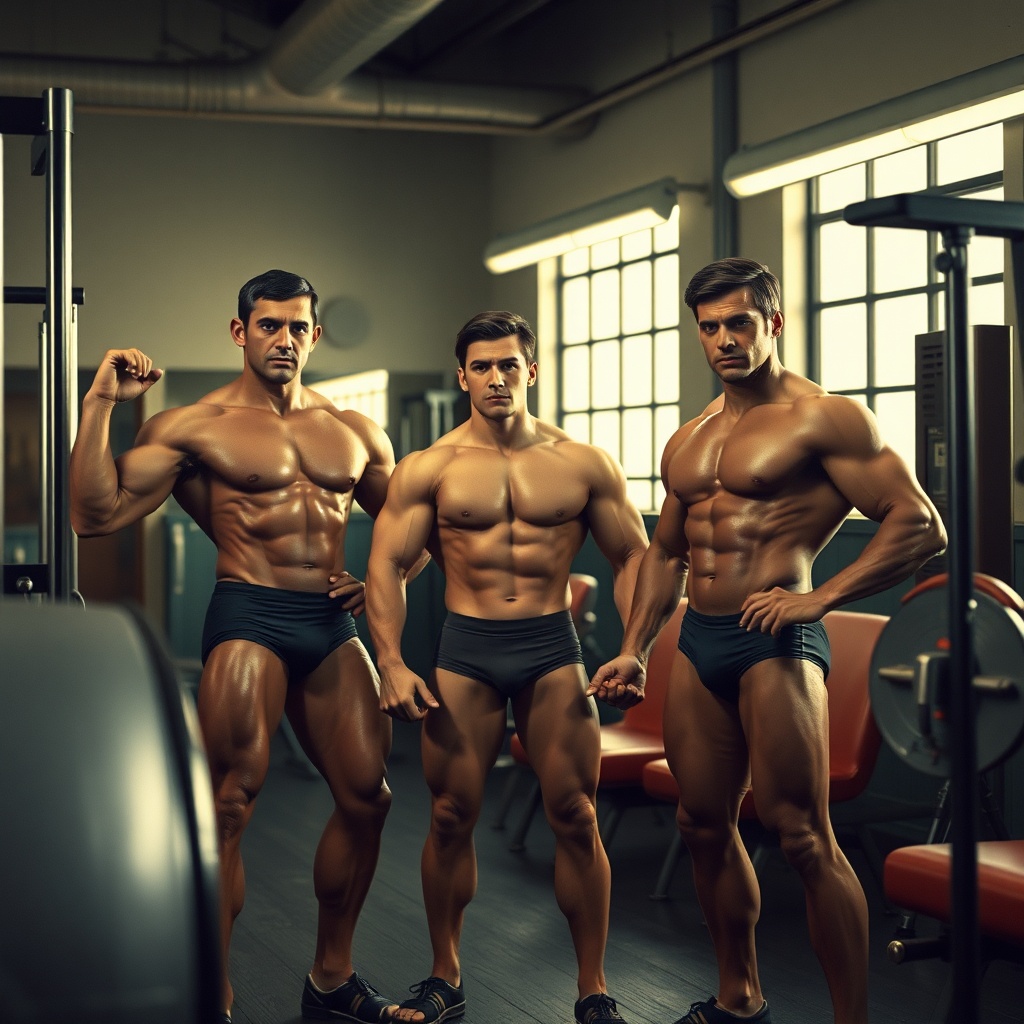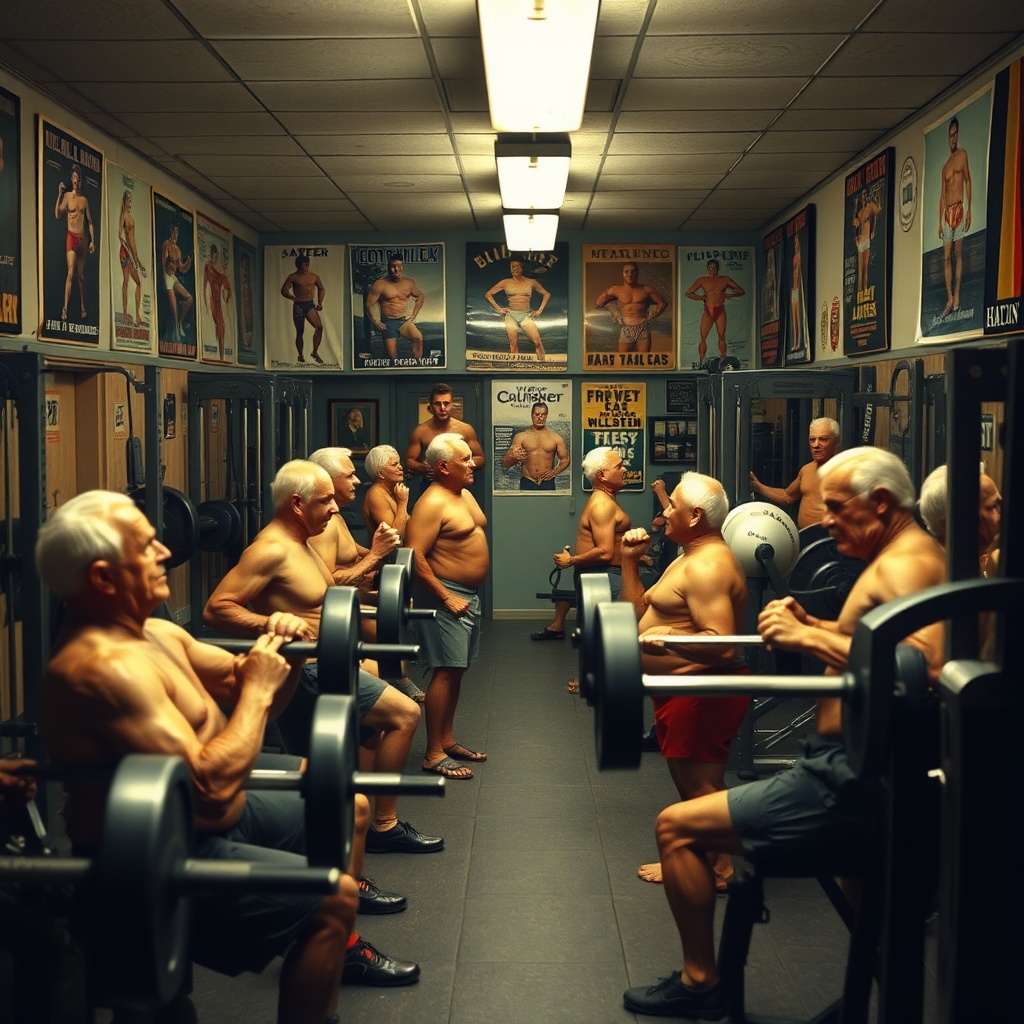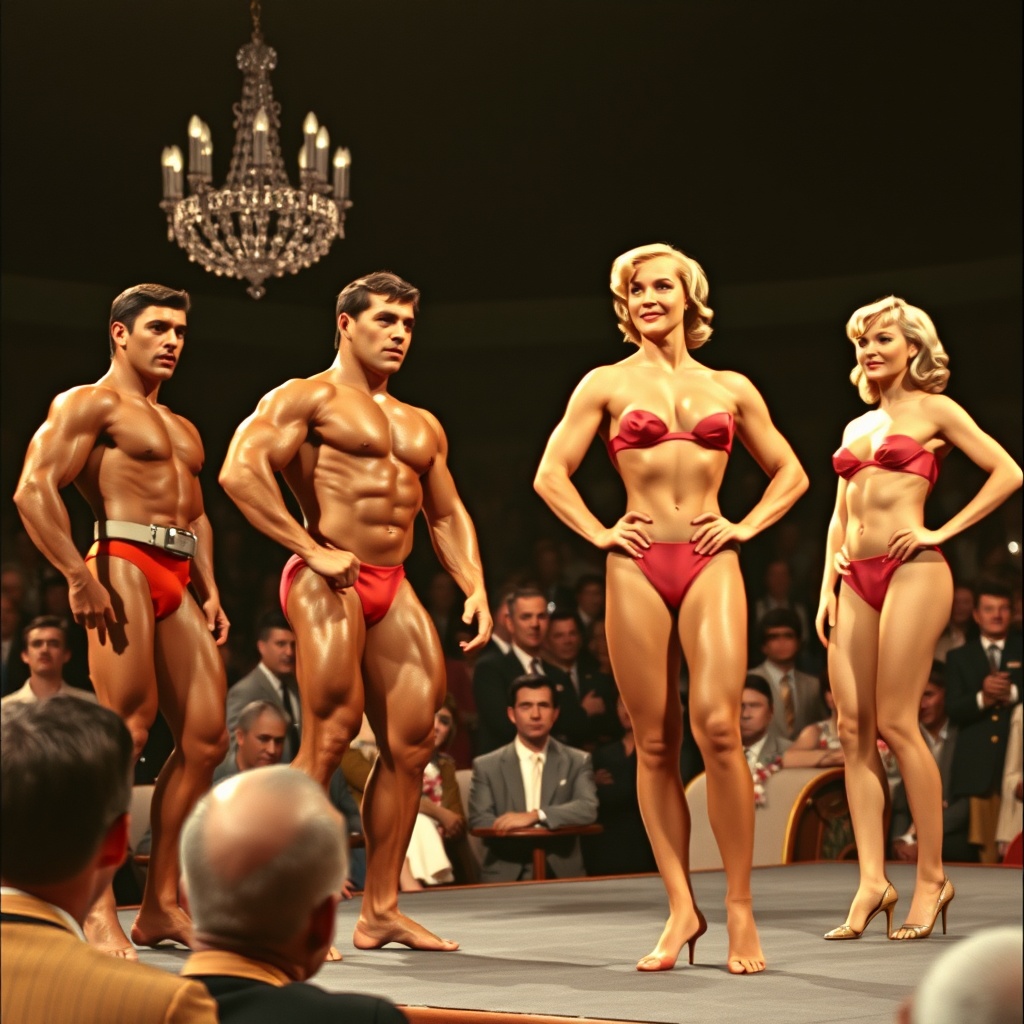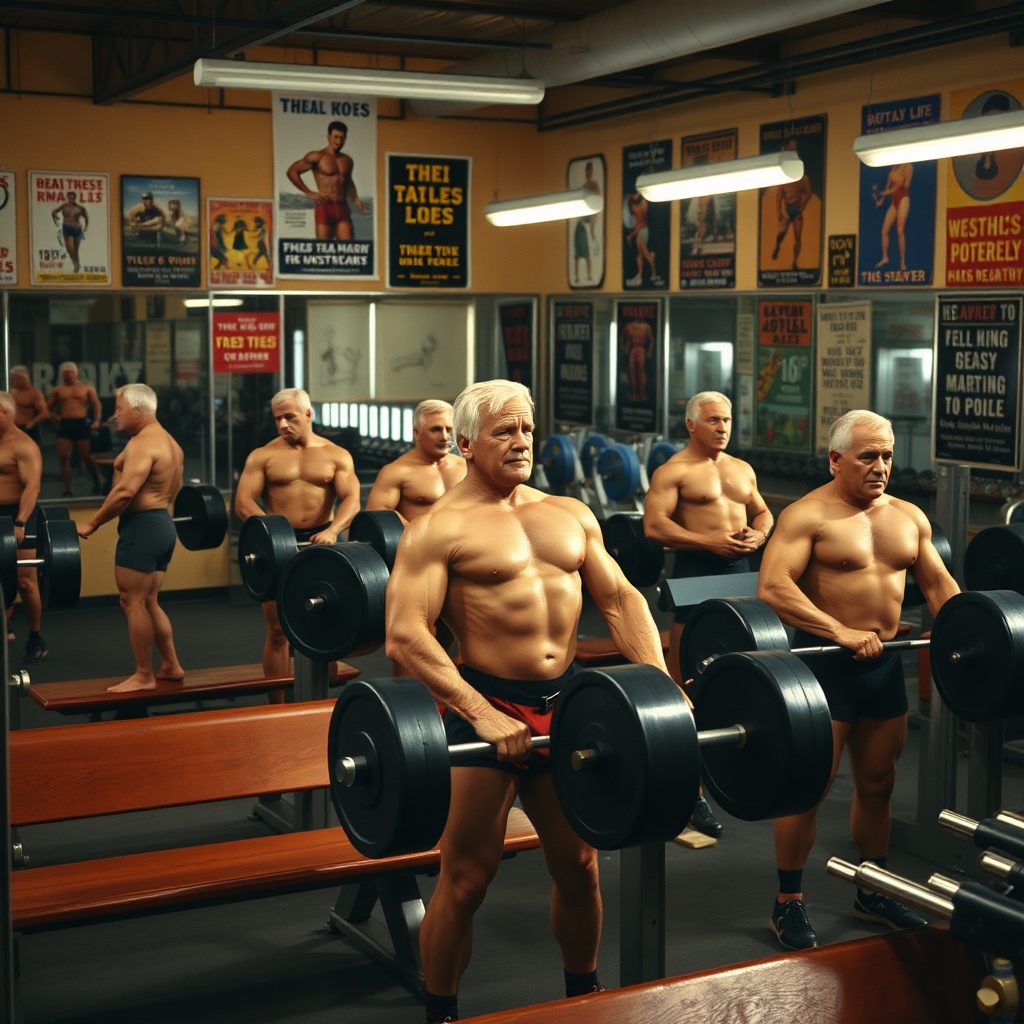Unveiling the Legends: Iconic Bodybuilders of the 1960s

Welcome to a journey back to the 1960s, a decade that marked a significant turning point in the world of bodybuilding. This era was not just about muscle; it was about passion, dedication, and the birth of legends that would inspire generations.
The Pioneers of Muscle
The 1960s introduced us to some of the most iconic bodybuilders, each of whom brought their unique flair and discipline to the sport. Let’s explore these legends!
- Arnold Schwarzenegger: Often referred to as the King of Bodybuilding, Arnold won the Mr. Olympia title seven times (1970-1975, 1980). His charisma and physique transformed bodybuilding into a mainstream phenomenon.
- Sergio Oliva: Known as “The Myth,” Sergio was a three-time Mr. Olympia (1967-1969). His incredible symmetry and size set new standards in the sport.
- Franco Columbu: A close friend of Arnold, Franco was a two-time Mr. Olympia (1976, 1981) and known for his strength and determination, showcasing that size and muscle could be combined with speed.
- Dave Draper: An iconic figure with a Hollywood appeal, Draper was known for his aesthetics and was a Mr. America titleholder. His influence extended beyond the stage into fitness and health.
- Bill Pearl: A legendary bodybuilder and author, Bill won Mr. Universe multiple times (1953, 1961, 1967) and is revered for his practical approach to bodybuilding and nutrition.
Impact on Society
These bodybuilders didn’t just compete; they became cultural icons, influencing fashion, fitness, and even cinema. Their dedication pushed the boundaries of what was considered achievable.
| Bodybuilder | Titles | Legacy |
|---|---|---|
| Arnold Schwarzenegger | Mr. Olympia (7x) | Transformed bodybuilding into a global phenomenon. |
| Sergio Oliva | Mr. Olympia (3x) | Set new standards for symmetry and size. |
| Franco Columbu | Mr. Olympia (2x) | Displayed the balance between strength and aesthetics. |
| Dave Draper | Mr. America | Influenced fitness culture and health awareness. |
| Bill Pearl | Mr. Universe (multiple) | Advocated for practical bodybuilding and nutrition. |
As we reflect on the Golden Age of Muscle, let us celebrate these legends who not only shaped the sport but also inspired countless individuals to pursue strength and health. Their legacies continue to motivate us to this day.
The Rise of Muscle Culture: How the 1960s Shaped Bodybuilding

The Emergence of Bodybuilding as a Mainstream Culture
In the 1960s, bodybuilding began to transform from a niche activity into a widespread cultural phenomenon. This decade witnessed a surge in interest, with individuals from various walks of life embracing fitness and strength training as a way to enhance their physical appearance and overall health. Do you remember the first time you saw someone flexing their muscles? That iconic image of strength was just beginning to take hold in popular culture.
The Influence of Icons
One of the pivotal figures in this transformation was Arnold Schwarzenegger, whose larger-than-life persona captured the imagination of many. Not only did he dominate competitions, securing titles such as Mr. Olympia, but he also became a symbol of what the ideal male physique could achieve. How did Arnold’s success inspire you or those around you? His charisma and dedication made bodybuilding an aspirational goal for many.
Media and Representation
The 1960s also saw an increase in media representation of bodybuilding. Magazines like Muscle & Fitness and Flex became popular, showcasing bodybuilders and their lifestyles. These publications were not just about workouts; they were about a lifestyle, a culture, and a community. Did you ever subscribe to any fitness magazines? They provided insights, tips, and motivation to countless enthusiasts.
The Role of Competitions
Bodybuilding competitions also gained prominence during this era. Events like the Mr. Olympia contest became stages where athletes could showcase their hard work and dedication. These competitions fostered a sense of camaraderie among bodybuilders and fans alike. Have you ever attended a bodybuilding competition? The energy in the room was palpable, as fans cheered for their favorites, celebrating strength and perseverance.
Changing Attitudes Towards Fitness
The cultural shift in the 1960s also reflected changing attitudes towards fitness and masculinity. The association of muscle with health and vitality resonated with a generation eager to break free from traditional norms. Did you notice a change in how people viewed fitness during that time? This period encouraged many to pursue physical fitness as a means of self-improvement and empowerment.
Conclusion: A Legacy of Strength
The rise of muscle culture in the 1960s laid the groundwork for future generations of bodybuilders. The decade not only shaped the sport but also influenced how society perceives strength and fitness today. In what ways do you think the legacy of the 1960s continues to impact bodybuilding? The passion ignited during this time remains alive, inspiring countless individuals to strive for their personal best.
Strength and Style: The Aesthetics of 1960s Bodybuilding

Exploring the Aesthetic Ideals
The 1960s marked a pivotal moment in bodybuilding, where strength and aesthetics began to intertwine in ways never seen before. Athletes not only aimed for power but also for a physique that was visually captivating. Can you recall the iconic poses that defined this era?
The Evolution of Bodybuilding Competitions
Competitions during the 1960s, such as the Mr. Olympia, showcased not just muscularity but also the artistry of the human form. Bodybuilders like Arnold Schwarzenegger and Franco Columbu became household names, not just for their strength but also for their elegant poses. What do you think made these competitors stand out?
The Influence of Aesthetics on Training
Bodybuilders of this era recognized that training routines needed to focus on symmetry and proportion. Techniques like the split routine and isolation exercises became popular. Have you ever experimented with different workout routines to achieve a specific look?
The Role of Nutrition
Aesthetics also extended to nutrition. Bodybuilders began to understand the importance of a balanced diet tailored to their training goals. Foods rich in protein and healthy fats became staples. How do you think dietary changes impacted their physiques?
Cultural Impact and Legacy
The 1960s was a time of cultural shifts that embraced fitness and health. Bodybuilding became a symbol of strength, discipline, and style. This era laid the foundation for future generations. Can you think of how the bodybuilding culture has evolved since then?
Conclusion: The Lasting Influence of 1960s Bodybuilding
The legacy of the 1960s bodybuilding scene is evident today, as contemporary bodybuilders continue to draw inspiration from the aesthetics of that time. The blend of strength and style remains a benchmark in the world of fitness. What aspects of the 1960s do you admire the most?
Pioneers of Power: The Trailblazers Who Defined an Era
Step back in time to the 1960s, a decade that witnessed the rise of bodybuilding into a celebrated sport and cultural phenomenon. The trailblazers of this era were not just athletes; they were icons who inspired millions with their dedication, discipline, and unparalleled physiques.
Meet the Pioneers
Let’s explore some of the most influential figures who shaped the golden age of muscle:
- Arnold Schwarzenegger
Perhaps the most recognized name in bodybuilding, Arnold’s charisma and incredible physique brought the sport into the mainstream. He won the Mr. Olympia title seven times and starred in films that showcased his impressive muscles.
- Franco Columbu
A close friend of Arnold, Franco was not only a champion bodybuilder but also a skilled powerlifter. His strength and determination made him a respected figure in the bodybuilding community.
- Lou Ferrigno
Famous for portraying the Hulk in the TV series, Lou’s massive build and dedication to training made him a household name. His journey from a shy teenager to a bodybuilding champion is truly inspiring.
- Dave Draper
A beloved figure in bodybuilding, Dave was known for his impressive aesthetic physique and warm personality. He also contributed to the sport through his writing and coaching.
- Mike Mentzer
Innovative in his training approach, Mike was a proponent of high-intensity training. His philosophy and competitive success paved the way for future generations of bodybuilders.
The Impact of These Icons
These pioneers did more than just lift weights; they:
- Popularized Bodybuilding: Their success led to a surge in interest in bodybuilding, inspiring countless individuals to pursue fitness.
- Influenced Media: Their stories and physiques were prominently featured in magazines and films, bringing bodybuilding into the public eye.
- Created a Community: They fostered a sense of camaraderie among bodybuilders, paving the way for events and competitions that continue to thrive today.
The legacy of these trailblazers continues to resonate in the world of fitness. Their dedication and passion are a reminder that with hard work and resilience, anyone can achieve greatness. Reflect on their journeys and consider how their influence might inspire you today.
From Amateur to Icon: The Transformation of Bodybuilders in the 60s
During the 1960s, bodybuilding underwent a significant transformation that captured the hearts and minds of many. The journey from amateur enthusiasts to iconic figures is a fascinating tale of dedication, discipline, and a relentless pursuit of excellence.
The Rise of Bodybuilding Competitions
In the early 1960s, bodybuilding competitions began to gain popularity, paving the way for aspiring athletes to showcase their hard work and artistic physiques. Events like Mr. Olympia and Mr. Universe emerged as prestigious platforms.
- Mr. Olympia was inaugurated in 1965 and quickly became the pinnacle of bodybuilding.
- Mr. Universe attracted international talent, pushing competitors to their limits.
Training Regimens: The Secret to Success
Bodybuilders of the 60s adhered to rigorous training regimens, which combined weightlifting with nutritional discipline. This era saw the development of innovative training techniques:
- Split Training: Dividing muscle groups into separate workout days.
- High-Volume Training: Focusing on multiple sets and repetitions for muscle hypertrophy.
- Nutrition: A balanced diet rich in proteins, healthy fats, and carbohydrates became essential.
Iconic Bodybuilders of the 60s
Several bodybuilders emerged as legends during this golden age. Their transformations from amateurs to icons serve as inspiration:
- Arnold Schwarzenegger: Arriving from Austria, Arnold’s charisma and physique captured the attention of the world.
- Lou Ferrigno: Known for his role as The Incredible Hulk, Lou’s dedication to the sport made him a household name.
- Franco Columbu: A close friend of Arnold, Franco showcased incredible strength and aesthetics.
The Cultural Impact of Bodybuilding
Bodybuilding in the 60s was not just a sport; it influenced culture, fashion, and lifestyle:
- Bodybuilders became symbols of strength and discipline.
- Fitness magazines began to feature bodybuilders prominently, spreading their influence.
- Television shows and movies started to include bodybuilding themes, further popularizing the sport.
The Legacy of the 1960s Bodybuilders
The transformation of bodybuilders in the 60s laid the groundwork for future generations. Their dedication and passion continue to inspire:
- The establishment of fitness centers and gyms across the globe.
- Increased participation in bodybuilding competitions.
- A growing awareness of health and fitness among the general public.
The 1960s marked a pivotal decade in the world of bodybuilding. From amateur enthusiasts to icons, these athletes transformed the landscape of fitness and left an indelible mark on history.
Muscle and Mind: The Philosophy Behind 1960s Bodybuilding
Understanding the Dual Nature of Bodybuilding
Bodybuilding in the 1960s was not just about lifting weights; it was a holistic approach that combined physical strength with a deep mental discipline. This era saw a remarkable transformation where bodybuilders understood that the journey to achieving the perfect physique also required a strong mindset.
The Mental Aspect of Bodybuilding
Many bodybuilders of the 1960s embraced philosophies that revolved around self-improvement and mental resilience. They believed that mental strength was as crucial as physical strength. Through visualization techniques and positive affirmations, they trained their minds to overcome challenges, both in and out of the gym.
Philosophical Influences
The bodybuilding community drew inspiration from various philosophical teachings:
| Philosopher | Key Ideas |
|---|---|
| Friedrich Nietzsche | The concept of the will to power, overcoming personal limits. |
| Albert Camus | Embracing the absurd, finding meaning in the struggle. |
| Eastern Philosophy | The balance of mind and body, harmony in training. |
Practical Applications in Training
Bodybuilders employed various techniques to merge mind and muscle:
Visualization: Imagining success before achieving it.
Mindfulness: Focusing on the present moment during workouts.
Goal Setting: Defining clear, achievable targets for both body and mind.
Community and Support
The bodybuilding community of the 1960s fostered a sense of camaraderie. Bodybuilders often trained together, sharing techniques and philosophies that enriched their journeys. This support system helped them stay motivated and focused on both physical and mental goals.
Enduring Legacy
The philosophies developed during this golden era of bodybuilding continue to influence today’s fitness culture. The understanding that mindset plays a significant role in achieving physical goals is as relevant now as it was then.
As we reflect on the golden age of bodybuilding, it becomes clear that the connection between muscle and mind was pivotal. The bodybuilders of the 1960s were not just athletes; they were philosophers, innovators, and pioneers who taught us the importance of holistic training.
The Championship Stage: Legendary Competitions of the 1960s
Welcome to a thrilling journey back to the 1960s, a decade that marked a monumental era in bodybuilding history. As we explore the legendary competitions of this time, let your memories of muscle and triumph come alive!
Mr. Olympia: The Pinnacle of Bodybuilding
The Mr. Olympia competition, first held in 1965, became the ultimate stage for bodybuilders to showcase their hard work and dedication. Imagine the excitement as the best athletes from around the world gathered to compete for the coveted title!
- 1965: The inaugural Mr. Olympia saw Larry Scott emerge as the first champion, his iconic biceps setting a new standard for the sport.
- 1966: The competition was fierce, but Scott defended his title, proving his dominance once again.
- 1967: Enter Sergio Oliva, the “Myth,” who took the stage by storm, showcasing a physique that left everyone in awe.
- 1968: Oliva continued to reign supreme, etching his name in the annals of bodybuilding history.
- 1969: Arnold Schwarzenegger burst onto the scene, winning his first Mr. Olympia title and beginning his legendary journey.
Can you recall the excitement of watching these incredible athletes compete? The atmosphere was electric!
The NABBA Universe Competition
Another iconic event of the 1960s was the NABBA (National Amateur Body-Builders’ Association) Universe competition. This event attracted competitors from all over the globe, showcasing the diverse talent in the sport.
- 1960: The competition featured legends like Reg Park and Bill Pearl, who were both champions in their own right.
- 1961: Park claimed victory once again, solidifying his status as a bodybuilding icon.
- 1962: The event gained popularity, leading to fierce rivalries and unforgettable performances.
- 1965: The NABBA Universe competition continued to thrive, with athletes pushing the limits of human potential.
As you reminisce about those days, can you picture the camaraderie and competition that defined these events?
Local and Regional Competitions
In addition to the prestigious national contests, local and regional competitions flourished during the 1960s, nurturing emerging talents and promoting the sport.
- Community Events: Local gyms and fitness clubs hosted competitions, fostering a sense of community among bodybuilders.
- Emerging Stars: Many future champions got their start in these smaller events, honing their skills and gaining exposure.
Did you ever participate in or attend one of these local competitions? The spirit of competition was palpable!
Final Thoughts
The 1960s was truly a golden age for bodybuilding, defined by legendary competitions that showcased unparalleled talent. From the Mr. Olympia to local contests, each stage played a vital role in shaping the future of the sport. As you reflect on these memories, consider how far bodybuilding has come and the legacy left by those champions of the 1960s.
Fitness Revolution: The Impact of 1960s Bodybuilding on Modern Health
Introduction to the Fitness Revolution
The 1960s marked a pivotal moment in the history of fitness and bodybuilding. It was an era filled with vibrant personalities and groundbreaking ideas that shaped the way we view health and fitness today. From the rise of iconic bodybuilders like Arnold Schwarzenegger and Franco Columbu to the introduction of innovative training techniques, the 1960s brought bodybuilding into the mainstream.
Bodybuilding Icons of the 1960s
Imagine walking into a gym during this dynamic decade. You would encounter athletes who not only transformed their own bodies but also inspired others to embark on their fitness journeys. Arnold Schwarzenegger, with his charismatic presence, became a symbol of strength and determination, while Franco Columbu showcased the importance of hard work and dedication.
Innovations in Training and Nutrition
The 1960s also introduced new training methods and nutritional philosophies. Bodybuilders began to recognize the significance of diet in achieving their fitness goals. High-protein diets, once a novelty, became a staple for those looking to build muscle. The concept of “lifting for aesthetics” emerged, emphasizing not just strength but also the importance of a well-proportioned physique.
The Influence of Competitions
Competitions like the Mr. Olympia pageant gained immense popularity, providing a platform for bodybuilders to showcase their hard work. Enthusiastic audiences flocked to these events, and television began to broadcast them, bringing bodybuilding into the homes of millions. These competitions not only celebrated physical prowess but also fostered a community of like-minded individuals passionate about fitness.
Legacy and Modern Health Trends
Fast forward to today, and the influence of the 1960s bodybuilding revolution is undeniable. Many of the principles established during this time persist in modern fitness culture. Resistance training remains a cornerstone of health regimens, and the focus on nutrition has evolved into a science that guides both young and elderly fitness enthusiasts alike.
Engaging with the Past
For those in their golden years, embracing the legacy of 1960s bodybuilding can be empowering. As you consider your own fitness journey, think about how you can incorporate some of these foundational concepts into your life. Whether it’s through gentle resistance training, mindful eating, or even just celebrating the joy of movement, the spirit of the 1960s lives on.
Conclusion: Continuing the Legacy
The fitness revolution ignited in the 1960s continues to inspire us today. By looking back at the triumphs of that era, we can not only appreciate the history of bodybuilding but also find motivation to pursue our health goals, no matter our age. Let the stories of these pioneers encourage you to embark on your own fitness journey, fostering strength, health, and joy in your life.
Beyond the Gym: The Cultural Influence of Muscle in the 1960s
The 1960s were not just a decade of change; they were a defining era for bodybuilding and the cultural perception of muscle. This was the time when muscle gained prominence beyond the gym, influencing art, film, and society at large.
The Rise of the Muscle Icon
With figures like Arnold Schwarzenegger and Franco Columbu emerging as prominent athletes, the decade saw the birth of the “muscle icon.” These individuals became symbols of physical perfection and strength, inspiring countless others to pursue bodybuilding. Their influence was felt:
- In Film: Movies like Hercules in New York showcased bodybuilders in leading roles.
- In Advertising: Brands began to use muscular figures in advertising campaigns, promoting ideals of health and vitality.
- In Fashion: The muscular physique started influencing fashion trends, promoting athletic wear as a staple in everyday life.
The Cultural Shift
The cultural landscape of the 1960s was changing rapidly. The rise of muscle culture coincided with various social movements:
- Counterculture Movement: Muscularity was often seen as a rebellion against the traditional norms of masculinity.
- Health Consciousness: The focus on fitness and health flourished as more people adopted weight training as a lifestyle.
- Feminine Strength: The 1960s also began to see women challenging conventional beauty standards, with some embracing strength training.
Impact on Media and Popular Culture
The media played a critical role in amplifying the muscle movement:
- Fitness Magazines: Publications like Muscle & Fitness and Flex became popular, providing workout advice and promoting bodybuilders.
- Television Shows: Shows featuring fitness segments became commonplace, encouraging viewers to adopt healthy lifestyles.
- Art and Literature: The muscular form began to appear in artistic representations, celebrating strength as a form of beauty.
The 1960s were pivotal in establishing muscle as a cultural phenomenon. Beyond the gym, the era’s influence reshaped societal views on health, strength, and beauty. As we reflect on this golden age of muscle, it’s essential to appreciate how these changes continue to resonate in today’s culture.
Timeless Techniques: Training Secrets from the Golden Age of Muscle
Introduction to Timeless Techniques
Welcome to a journey back in time to the Golden Age of Muscle, a period where icons like Arnold Schwarzenegger and Franco Columbu dominated the bodybuilding scene. In this era, bodybuilders employed techniques that not only shaped their impressive physiques but also laid the groundwork for modern training methods. Let’s explore some of these timeless techniques that you can still incorporate into your routines today.
1. The Power of Compound Movements
During the 1960s, bodybuilders understood the importance of compound movements. Exercises such as squats, deadlifts, and bench presses were staples in their training regimens. These exercises engage multiple muscle groups, promoting overall strength and muscle development.
Tip: If you’re looking to build strength, consider integrating compound movements into your routine. Start with lighter weights to master the form before progressing.
2. The Art of Supersets
Supersets, or performing two exercises back-to-back with little rest in between, were a favorite in the Golden Age. This method not only saves time but also increases intensity. For example, pairing a bicep curl with a tricep extension can enhance muscle fatigue and growth.
Tip: Try incorporating supersets into your workouts. Choose opposing muscle groups to maximize efficiency and keep your heart rate up.
3. Emphasis on Nutrition
Bodybuilders of the 60s were pioneers in recognizing the role of nutrition in achieving their goals. They focused on high-protein diets, rich in lean meats, eggs, and dairy, to fuel their workouts and support recovery.
Tip: Consider consulting with a nutritionist to develop a diet that meets your individual needs. Remember, proper nutrition is as crucial as your training!
4. Consistency and Routine
Consistency was key for bodybuilders during the Golden Age. They followed structured routines, often training six days a week. This dedication allowed them to track progress and continuously challenge their bodies.
Tip: Establish a workout schedule that works for you and stick to it. Consistency will bring results over time.
5. The Mental Aspect
Lastly, the mental discipline showcased by athletes of this era cannot be overstated. Visualization techniques, positive affirmations, and a strong mindset played significant roles in their success.
Tip: Incorporate mental training into your routine. Set clear goals, visualize your success, and maintain a positive attitude to enhance your performance.
Conclusion: Embrace the Golden Age Techniques
The techniques from the Golden Age of Muscle remain relevant and effective today. By learning from the past, you can enrich your training experience and achieve your fitness goals. Remember, it’s never too late to start!
